Grey Reef Shark
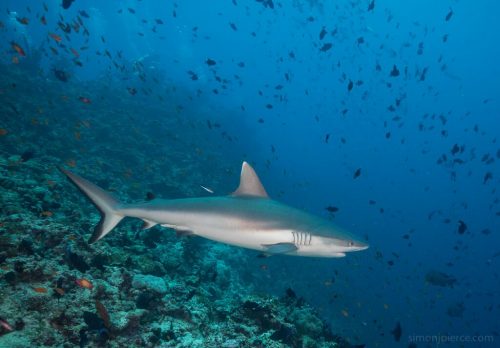
Carcharhinus amblyrhynchos
This is a classically shaped requiem shark. Like many species in the genus Carcharhinus, it is dark grey on the dorsal surface and paler, almost white on the ventral side. It can be distinguished from other species in the genus by the characteristically dark margin on the entire trailing edge of the caudal fin. In the Western Indian Ocean and Red Sea populations it has a white-edged first dorsal fin. This population has been described by some as a distinct species (Carcharhinus wheeleri) (Compagno et al. 2005, Smale 2009). This species is sometimes mistaken for the blacktip reef shark as they life in similar habitats, but the two species have strikingly different colour patterns . Grey reef sharks are social, gathering in groups during the day and hunting alone at night. They are inquisitive and commonly approach divers. They are also believed to be territorial and have been documented to arch their backs and push their pectoral fins downward and swim in an exaggerated pattern as part of a territorial display. They are strong and potentially dangerous but are not likely to attack humans unless threatened (Compagno et al. 2005).
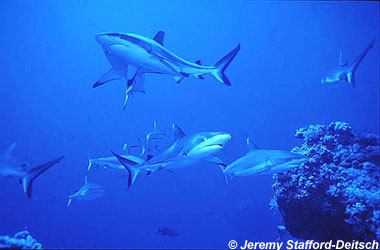
Order: Carcharhiniformes
Family: Carcharhinidae
Genus: Carcharhinus
Species: amblyrhynchos
Common Names
English language common names include grey reef shark, blacktail reef shark, black-vee whaler, gray reef shark, gray shark, gray whaler shark, and longnose blacktail shark. Other common names from across the world include:
requin dagsit (French)
tiburón de arrecifes (Spanish)
Importance to Humans
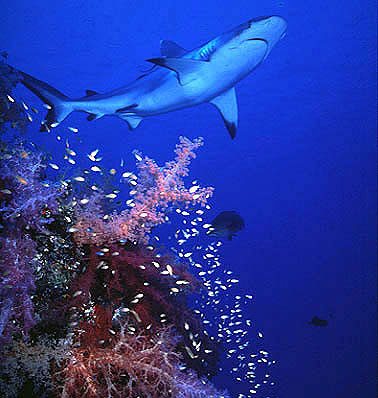
The grey reef shark is fished commercially, mainly for their fins which are used in shark fin soup. The meat is also consumed and used as fishmeal. This species is more valued, however, in dive tourism as it shows high site fidelity and is a common inhabitant of coral reef dive sites (Smale 2009).
Danger to Humans
The grey reef shark is considered one of the more aggressive sharks but will typically only show aggression towards a person when it feels threatened. According to the International Shark Attack File, the grey reef shark is responsible for 8 confirmed shark bites on humans, one of which was fatal (ISAF 2018).
This shark often shows curiosity and approaches divers. If cornered or threatened in some way, the grey reef shark displays explicit threat behavior including raising its snout, depressing the pectoral fins, and arching its back while swimming with an exaggerated sway. If the threat continues, the shark may immediately flee or may deliver a quick bite prior to retreating (Compagno et al. 2005). This species of shark is also more likely to attack while solitary rather than schooling, perhaps due to an increased feeling of vulnerability (Nelson 1986).
View shark attacks by species on a world mapConservation
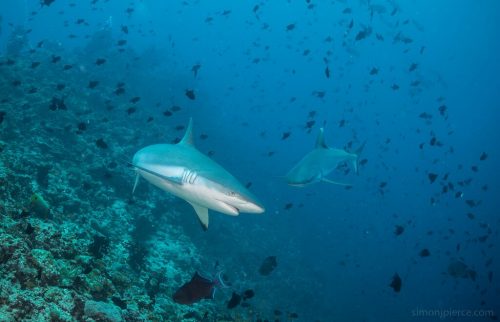
IUCN Red List Status: Near Threatened
The grey reef shark exhibits strong site fidelity to coral reefs, a habitat that is becoming increasingly more restricted, making them easier to catch and more susceptible to overfishing. In addition, their life history characteristics (small litter size and relatively late age at maturity) make them particularly susceptible to population decline. At this time, there is not enough data available to make reliable assessments of their global population status, but some local populations in Hawaii and the Chago Archipelago indicate that these population has been severely impacted (Smale 2009).
The grey reef shark is currently listed by the World Conservation Union (IUCN) as “Near Threatened”. More fisheries data is required for future assessment. The IUCN is a global union of states, governmental agencies, and non-governmental organizations in a partnership that assesses the conservation status of species.
> Check the status of the gray reef shark at the IUCN website.
Geographical Distribution
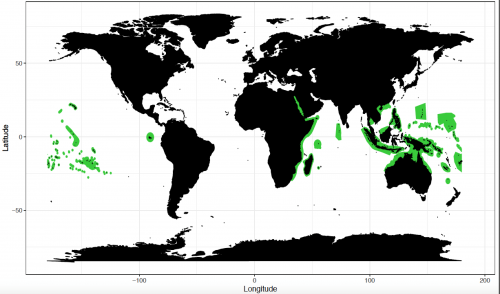
The grey reef shark is limited to the Pacific and Indian Oceans. In the Indo-Pacific, it is found in Northern South Africa, the waters off Madagascar and in the Mauritius-Seychelles region and up into the Red Sea. In the western Pacific Ocean, it ranges from southern China to northern Australia and the Tuamoto Archipelago (Compagno et al. 2005, Smale 2009). It is one of the most common reef sharks in the Pacific Ocean, along with the blacktip reef shark (Carcharhinus melanopterus) and the whitetip reef shark (Triaenodon obesus) (Compagno 1984). However, it is primarily located in areas that lack extensive human activity.
Habitat
The grey reef shark prefers shallow tropical and subtropical waters near coral atolls and lagoons adjacent to reef habitats. Its depth ranges from 0-164 feet (0-50 m). Although more active during the night, grey reef sharks sometimes form schools or loose aggregations during the day that swim close to the bottom, over flats or reef-drop-off habitats (Compagno et al. 2005, Smale 2009). Tagging studies show that sharks living near ocean reefs are nomadic and travel along the reef habitat each day (Compagno 1984). However, the grey reef shark generally has a high site fidelity and tends to return day after day to the same site (Smale 2009).
Biology
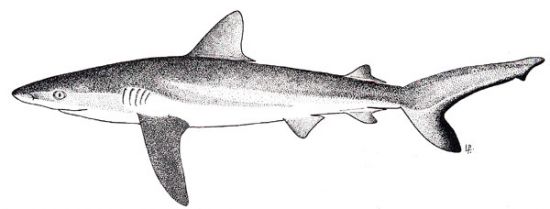
Distinctive Features
This shark is medium to large in size, growing up to 6-7 feet in total length. It has a long, broadly rounded snout and large eyes. It does not have an interdorsal ridge running between the first and second dorsal fins (Compagno et al. 2005). The origin of the first dorsal fin is over, or just in front of, the free rear tips of the pectoral fins, while the second dorsal fin originates over the anal fin origin. The first dorsal fin is semifalcate with a narrowly rounded or pointed tip and the pectoral fins are large, narrow, and falcate in shape with narrowly rounded or pointed tips (Compagno 1984).
Coloration
The dorsal side of the grey reef shark ranges from dark grey to bronze grey, paling to a white ventral side. The entire trailing edge of the caudal fin has a distinct wide black margin. The pectorals, second dorsal, anal, and pelvic fins have black or dusky tips while the first dorsal fin is either entirely grey or irregularly edged with white (Compagno et al. 2005).
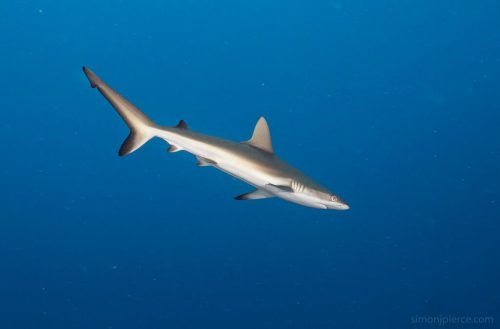
Dentition
Compagno (1984) reports that the teeth of the grey reef shark are triangular and serrated with 13-14 teeth in each jaw half. The upper teeth are described as narrow and serrated, semi-erect to oblique in shape with high cusps, while the crown feet have coarser serrations. The lower teeth are erect or semi-oblique with narrowly serrated cusps.
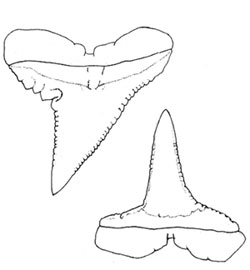
Size, Age, and Growth
Males of this species grow up to about 185 cm in length and females to about 190 cm in length. Maturity occurs at about 120-140 cm in length for males and about 125 cm in length for females (Smale 2009) and at about 7 years old for both sexes. Size at birth is between 45-75 cm in length. Maximum age is believed to be about 25 years (Compagno et al. 2005).
Food Habits
Reef fishes, along with smaller quantities of cephalopods (squid and octopus), and crustaceans (shrimp and lobster), provide the majority of the grey reef sharks’ prey (Smale 2009). Reef shark prey also includes bony fish including cowfish, surgeonfish, and butterflyfish. Most of the feeding activity occurs at night, which is when the shark is most active (Compagno et al. 2005).
Reproduction
The grey reef shark is a viviparous species. The embryos are nourished via a yolksac placenta during gestation inside the mother. The gestation period lasts approximately 12 months, followed by live birth of a litter of 1-6 pups (Compagno et al. 2005, Smale 2009).
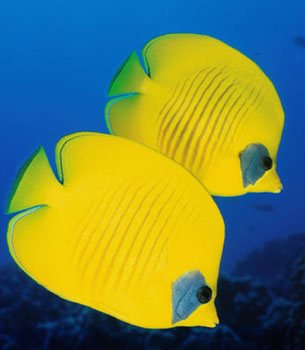
Predators
Predators of the grey reef shark include larger sharks such as the silvertip shark (Carcharhinus albimarginatus), tiger sharks (Galeocerdo cuvier) and the great hammerhead shark (Sphyrna mokarran) (Frisch et al. 2016).
Parasites
The grey reef shark is host to parasitic copepods including Nemesis robusta (gill filaments) and Alebion carchariae (snout, fins, body). These copepods were documented on specimens from waters off western Australia. Ganthiid isopod larvae have also been reported on the gills of this shark as have eggs of nematodes of the genus Huffmanela (Justine 2004).
Taxonomy
The grey reef shark was originally described as Carcharias amblyrhynchos by Bleeker in 1856. He later changed this name to the currently valid name of Carcharhinus amblyrhynchos. The genus name Carcharhinus is derived from the Greek “karcharos” meaning sharpen and “rhinos” meaning nose. Synonyms used in previous scientific literature that refer to the grey reef shark according to Smale (2009) include Carcharias nesiotes (Snyder 1904), Carcharhinus menisorrah (Whitley 1944), Galeolamna fowleri (Whitely 1944), Galeolamna turfiensis (Whitely 1949), Galeolamna coongoola (Whitely 1964), and Carcharhinus wheeleri (Garrick 1982).
References
Compagno, L., Dando, M., & Fowler, S. (2005) A Field Guide to the Sharks of the World. London: Harper Collins Publishers Ltd.
FRISCH, A.J. & IRELAND, M. & RIZZARI, J.R. & LÖNNSTEDT, O.M. & MAGNENAT, K.A. & MIRBACH, C.E. & HOBBS, J.-P.A. (2016). Reassessing the trophic role of reef sharks as apex predators on coral reefs. Coral Reefs, 35 (2): 459–472
Justine J-L. Three new species of Huffmanela Moravec, 1987 (Nematoda: Trichosomoididae) from the gills of marine fish off New Caledonia. Syst Parasitol. 2004;59:29–37.
Smale, M.J. 2009. Carcharhinus amblyrhynchos. The IUCN Red List of Threatened Species 2009: e.T39365A10216946. http://dx.doi.org/10.2305/IUCN.UK.2009-2.RLTS.T39365A10216946.en.
Revised by Lindsay French and Gavin Naylor 2018
Original preparation by Cathleen Bester